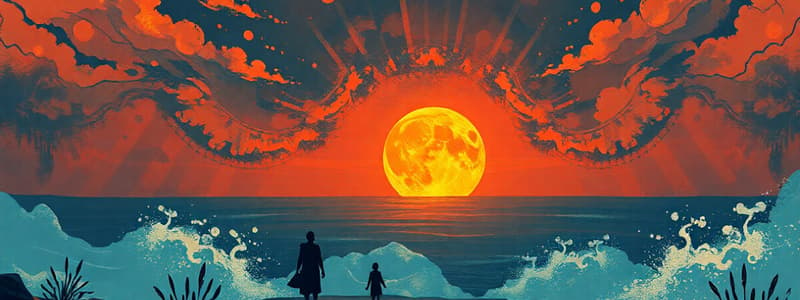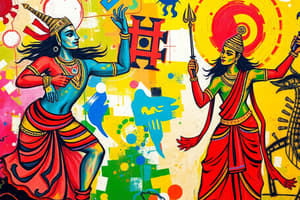Podcast
Questions and Answers
How did British colonialism primarily influence the emergence of Indian Writing in English (IWE)?
How did British colonialism primarily influence the emergence of Indian Writing in English (IWE)?
- It introduced English education, creating a class of Indians proficient in the language and literature. (correct)
- It mandated that all literary works in India be written and published in English.
- It financially supported Indian writers who chose to write in English to promote cultural exchange.
- It discouraged the development of Indian languages, leading writers to adopt English.
Which of the following is a central theme frequently explored in Indian Writing in English (IWE)?
Which of the following is a central theme frequently explored in Indian Writing in English (IWE)?
- Exploration of the impact of colonialism and the search for Indian identity. (correct)
- Glorification of the British Empire and its impact on Indian society.
- Promotion of Western cultural values and ideals as superior to Indian traditions.
- Nostalgic portrayals of ancient Indian civilizations before colonial influence.
In what way does the concept of 'hybridity' manifest in Indian Writing in English (IWE)?
In what way does the concept of 'hybridity' manifest in Indian Writing in English (IWE)?
- Through the exclusive use of Sanskrit and ancient Indian languages.
- By strictly adhering to traditional Western literary styles and themes.
- By rejecting any foreign influence and focusing solely on indigenous narratives.
- In the blending of Indian and Western cultures, languages, and literary techniques. (correct)
Which author is celebrated for creating the fictional town of Malgudi as the setting for his works, portraying everyday Indian life?
Which author is celebrated for creating the fictional town of Malgudi as the setting for his works, portraying everyday Indian life?
Which literary technique, often found in Indian Writing in English, involves the blending of realistic and fantastical elements?
Which literary technique, often found in Indian Writing in English, involves the blending of realistic and fantastical elements?
How has Indian Writing in English (IWE) influenced global perceptions of India and its culture?
How has Indian Writing in English (IWE) influenced global perceptions of India and its culture?
Which issue is often debated regarding Indian Writing in English (IWE)?
Which issue is often debated regarding Indian Writing in English (IWE)?
What characterized the 'Nationalist Phase' in the evolution of Indian Writing in English (IWE)?
What characterized the 'Nationalist Phase' in the evolution of Indian Writing in English (IWE)?
Arundhati Roy's 'The God of Small Things' primarily addresses which themes?
Arundhati Roy's 'The God of Small Things' primarily addresses which themes?
Which of the following best describes the 'Contemporary Phase' of Indian Writing in English (IWE)?
Which of the following best describes the 'Contemporary Phase' of Indian Writing in English (IWE)?
What is a significant challenge faced by Indian Writing in English (IWE) in terms of reaching a wider readership?
What is a significant challenge faced by Indian Writing in English (IWE) in terms of reaching a wider readership?
Which of the following authors is known for their exploration of historical and environmental themes, often set in India and Southeast Asia?
Which of the following authors is known for their exploration of historical and environmental themes, often set in India and Southeast Asia?
What is the significance of using Indian idioms and vernacular in Indian Writing in English (IWE)?
What is the significance of using Indian idioms and vernacular in Indian Writing in English (IWE)?
What role does post-colonial narrative strategy play in Indian Writing in English (IWE)?
What role does post-colonial narrative strategy play in Indian Writing in English (IWE)?
Which author is known for exploring themes of alienation, family dynamics, and the inner lives of women in her novels?
Which author is known for exploring themes of alienation, family dynamics, and the inner lives of women in her novels?
In Aravind Adiga’s 'The White Tiger', what critical perspective is offered?
In Aravind Adiga’s 'The White Tiger', what critical perspective is offered?
Which novel is Vikram Seth acclaimed for, as it provides a panoramic view of post-independence India?
Which novel is Vikram Seth acclaimed for, as it provides a panoramic view of post-independence India?
Which of the following is a common critique of Indian Writing in English (IWE)?
Which of the following is a common critique of Indian Writing in English (IWE)?
What is Mulk Raj Anand primarily known for in his literary works?
What is Mulk Raj Anand primarily known for in his literary works?
Which narrative technique is characterized by the exploration of characters' inner thoughts and emotions?
Which narrative technique is characterized by the exploration of characters' inner thoughts and emotions?
Flashcards
Indian Writing in English (IWE)
Indian Writing in English (IWE)
Literary works by Indian authors in English, reflecting Indian experiences and themes.
Post-colonialism in IWE
Post-colonialism in IWE
Impact of British rule on Indian society, culture, and individuals.
Identity in IWE
Identity in IWE
A recurring theme exploring the search for and assertion of Indian identity.
Hybridity in IWE
Hybridity in IWE
Signup and view all the flashcards
Mulk Raj Anand
Mulk Raj Anand
Signup and view all the flashcards
R.K. Narayan
R.K. Narayan
Signup and view all the flashcards
Raja Rao
Raja Rao
Signup and view all the flashcards
Anita Desai
Anita Desai
Signup and view all the flashcards
Vikram Seth
Vikram Seth
Signup and view all the flashcards
Salman Rushdie
Salman Rushdie
Signup and view all the flashcards
Arundhati Roy
Arundhati Roy
Signup and view all the flashcards
Amitav Ghosh
Amitav Ghosh
Signup and view all the flashcards
Jhumpa Lahiri
Jhumpa Lahiri
Signup and view all the flashcards
Kiran Desai
Kiran Desai
Signup and view all the flashcards
Aravind Adiga
Aravind Adiga
Signup and view all the flashcards
Nationalist Phase of IWE
Nationalist Phase of IWE
Signup and view all the flashcards
Contemporary Phase of IWE
Contemporary Phase of IWE
Signup and view all the flashcards
Magical Realism in IWE
Magical Realism in IWE
Signup and view all the flashcards
Use of Indian Idioms in IWE
Use of Indian Idioms in IWE
Signup and view all the flashcards
Authenticity in IWE
Authenticity in IWE
Signup and view all the flashcards
Study Notes
- Indian Writing in English (IWE) refers to the body of literary work by Indian authors in the English language.
- It encompasses novels, short stories, poetry, and drama, reflecting Indian experiences, themes, and cultural contexts.
- IWE has gained global recognition and significantly contributed to world literature.
Historical Background
- The emergence of IWE is closely linked to British colonialism in India.
- English education was introduced in India during the colonial era, leading to a new class of educated Indians proficient in English.
- Early IWE was influenced by Western literary styles and themes but gradually evolved to express Indian identity and experiences.
Key Themes and Characteristics
- Post-colonialism: Many IWE works explore the impact of British rule on Indian society, culture, and individuals.
- Identity: The search for and assertion of Indian identity is a recurring theme, often juxtaposed with Western influences.
- Culture and Tradition: IWE frequently portrays Indian customs, traditions, and social structures, both preserving and critiquing them.
- Social Issues: Writers often address issues such as caste discrimination, poverty, gender inequality, and religious conflict.
- Hybridity: The blending of Indian and Western cultures and languages is a notable characteristic of IWE.
- Spirituality: Philosophical and spiritual themes from Indian religions and traditions are often explored.
Prominent Authors and Works
- Mulk Raj Anand: Known for his novels depicting the lives of marginalized communities.
- R.K. Narayan: Celebrated for his works set in the fictional town of Malgudi, portraying everyday Indian life.
- Raja Rao: Notable for his experimental use of language and exploration of Indian philosophy in novels.
- Anita Desai: Explores themes of alienation, family dynamics, and the inner lives of women in her novels.
- Vikram Seth: Acclaimed for his epic novel "A Suitable Boy," which provides a panoramic view of post-independence India.
- Salman Rushdie: Known for his magical realism and exploration of identity, migration, and political issues.
- Arundhati Roy: Gained fame for her novel "The God of Small Things," addressing themes of caste, family, and forbidden love.
- Amitav Ghosh: Explores historical and environmental themes in his novels, often set in India and Southeast Asia.
- Jhumpa Lahiri: Known for her short stories and novels about the experiences of Indian immigrants in America.
- Kiran Desai: Addresses globalization, cultural displacement, and class differences in her works.
- Aravind Adiga: Gained recognition for his novel "The White Tiger," which offers a critical perspective on contemporary India.
Evolution and Development
- Early Phase: Characterized by imitative writing and attempts to adapt Western forms to Indian contexts.
- Nationalist Phase: Marked by a focus on Indian identity, culture, and the struggle for independence.
- Modernist Phase: Experimentation with narrative techniques, language, and psychological realism.
- Contemporary Phase: Diverse range of voices and themes, reflecting the complexities of modern India and its diaspora.
Literary Styles and Techniques
- Realism: Depiction of everyday life and social realities in India.
- Magical Realism: Blending of realistic and fantastical elements to convey deeper truths.
- Stream of Consciousness: Exploration of characters' inner thoughts and emotions.
- Use of Indian Idioms and Vernacular: Incorporation of Indian languages and cultural references in English writing.
- Post-colonial Narrative Strategies: Subversion of colonial discourses and representation of marginalized voices.
Influence and Impact
- IWE has played a significant role in shaping perceptions of India and Indian culture worldwide.
- It has contributed to the enrichment of English literature by introducing new perspectives and styles.
- IWE has provided a platform for Indian writers to address social and political issues and advocate for change.
Criticism and Challenges
- Authenticity: Debates about whether IWE accurately represents Indian culture and experiences.
- Language: Concerns about the use of English as a medium of expression and its accessibility to Indian readers.
- Representation: Critiques about the portrayal of certain communities and issues in IWE.
- Market and Audience: Challenges in reaching a wider readership and competing with Western literature.
Studying That Suits You
Use AI to generate personalized quizzes and flashcards to suit your learning preferences.




